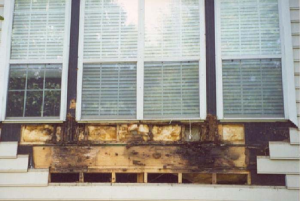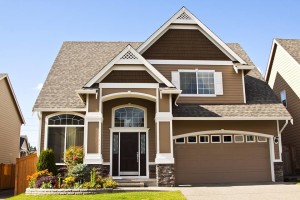New Home Exterior Siding Can Increase The Value Of Your Home & Save You Money –
Not To Mention It Can Dramatically Increase The Beauty of Your Home.
One of the most often asked questions we get is; “when do I know if I need to replace my siding?” Hopefully, after reading this article you’ll have an answer to that question. While it is impossible to list out every situation that would indicate you need to replace your home siding, these are, based on our experience, the seven most common reasons you should replace your siding.

1. Rot, Rot and More Rot.
Siding is the number one protection against the elements. It never pay’s to go with cheaper siding,” say’s Tony Bennett, owner of Titan Exteriors NW. Siding is what protects your home from the elements, keeping your family comfortable and safe.” If your siding has begun to rot or crumble, then it simply can’t perform this essential role. In cases of isolated damage, you may be able to get away with just repairing or replacing the affected siding, but if the rot has spread across the exterior, there’s nothing to do but start over, this time with a rot-resistant material.
Tony Bennett recommends Hardi-Plank; “Look, I have been in this industry for close to 30 years. I have tried everything. I can honestly tell you that nothing holds up to the elements here in the Pacific Northwest better than Hard-Plank fiber cement home siding.”
But there is even a larger problem.
According to Tony Bennett; “if you can see your siding starting to warp, buckle, or see signs of rot, then the situation is a lot worse than you may think. In many cases, by the time you see an outward manifestation of siding failure (like rot), then it’s probably a lot worse behind the siding… where you can’t see what’s going on.”
Just take a look at this image of a home where we went in to repair and replace some home exterior siding.

As you can see, the siding failed and was unable to protect the home against the elements. Eventually the moisture and rain got behind the siding and caused extensive damage to the home. Don’t let this happen to you. Get your siding inspected regularly. We recommend getting it inspected after every winter.

2. Chips, Cracks and Gaps.
This is probably the single biggest point of failure that we find when we get called out to inspect a homes exterior siding. Not only does it make the siding look terrible, but it is also the way moisture get’s in behind the siding. Which is what causes the rot we discussed in section one above. Another thing to remember: if moisture can get in, so can bugs. This is why it is critically important to check your siding every year. You see, many less than reputable contractors you will use cheap contractor grade caulking. It’s just one way they can pad their profits. This type of caulking simply won’t hold up to Oregon weather. Our frigid winters, followed by our blistering summers destroys cheaper caulking. The end result, you’ve lost your water tight seal.

3. Out of Time
Look, we get it. Maintaining your siding is time consuming. But despite this, it is absolutely critical you do so. Especially if you have wood clad, panel, or cedar siding. But it’s even more critical if you have vinyl siding. You see, contrary to popular belief, vinyl siding doesn’t hold up to well in Pacific Northwest weather. The reason: expansion and contraction. The cold here in Oregon can literally shrink your vinyl siding. The summers cause it to grow and expand. This constant expansion and contraction messes with the structural integrity of the siding itself. Or worse, if you have an east – west facing home, it can get hot enough hear to literally warp your siding. Again, the key here is constant inspections and maintenance.
And don’t let the “salesman” fool you. In many cases you just can’t clean vinyl siding with just a hose, not here in the Pacific Northwest anyway. If it was so easy to clean that all you need is a hose… why are there so many online videos and websites about cleaning your vinyl siding with bleach or vinegar? In fact, get a North – South facing home and that shade along with our super wet winters and you’ll get a wall of green.

However, if you no longer have the time or energy to maintain your exterior siding, it’s only a matter of time before you’ll start seeing chips, cracks, and gaps. So before that happens, consider upgrading to low-maintenance fiber cement siding. It requires minimal maintenance, looks absolutely amazing, and can save you a ton of money. Not only that, but with our simple and fast financing, it’s easily affordable.

4. Skyrocketing Bills
No obvious signs of damage to your home exterior? Already checked your attic and your insulation? Windows are new? Then why is your utility bills still climbing? Check for a less obvious reason. Like drafts near walls and windows, or around electrical switches and electric receptacles.” If you can feel a draft, chances are that you may need additional insulation between your walls… and new siding. If your siding is failing, then there is a pretty good chance it’s not protecting you – or your home – against the elements. Just like mositure cen get in between the cracks and gaps, so can that frigid cold air.

5. Hidden Hazards
“When you take a walk around your hose, take a minute and inspect your exterior siding closely. Just don’t look at it from one angle, look at it from every angle possible,” says Bennett. “What your looking for is siding that no longer lies flat.” Bulging or warped siding panels can be like the tip of an iceberg, warning you of dangers hidden behind the wall where you can’t see it. When confronted with this evidence, it’s a pretty safe bet that there may be serious damage beneath the siding.” Please, don’t hesitate to call us. It doesn’t cost you anything to get a professional opinion. We would love to come out and put your mind at ease if nothing is wrong… or in a worst case scenario, to give you an honest opinion on what the real problem is and a “honest” price on what it’s going to cost you to get it fixed.

6. Moisture and Mold Inside The House
Inside your home, wherever you discover the effects of moisture buildup—be it rot, mold, or mildew—move quickly to “investigate the condition of the same area on the home exterior,” says Bennett. If damaged siding appears to be to blame then “you need to upgrade the siding, or the insulation, or both.” Mold is nothing to play around with. If you even think you may have mold, contact a professional.

7. Curb Appeal
Does your home just look plain drab? Does it look old? Or are you planning to move? Then you should seriously consider replacing your homes siding. If fact, according to Remodeling Magazines, replacing your siding installation offers one of the best returns on your investment.
